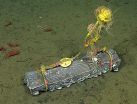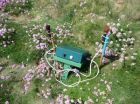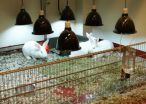(Press-News.org) April 9, 2014 –The spread of the antibiotic-resistant pathogen MRSA (methicillin-resistant Staphylococcus aureus) remains a concerning public health problem, especially among doctors trying to determine appropriate treatment options for infected patients. Bacterial pathogens, such as MRSA, cause disease in part due to toxicity, or the bacterium's ability to damage a host's tissue. In a study published online today in Genome Research, researchers used the genome sequence of MRSA to predict which isolates were highly toxic, thus potentially personalizing the treatment of individual MRSA infections.
To study MRSA's toxicity, "the standard approach has always been to focus on a single or small number of genes and proteins," said lead author Ruth Massey, from the University of Bath. However, this has not always been successful because toxicity is a complex trait encoded by many genetic loci.
In this new study, the authors used whole genome sequences from 90 MRSA isolates to identify over 100 genetic loci associated with toxicity. Despite belonging to the same ST239 clone, the isolates varied greatly in toxicity.
Importantly, the highly toxic isolates shared a common genetic signature. By looking for this signature in the MRSA genome, the researchers were able to predict which isolates were the most toxic and thus more likely to cause severe disease when used to infect mice.
"As the cost and speed of genome sequencing decreases, it is becoming increasingly feasible to sequence the genome of an infecting organism," said Massey. In a clinical setting, sequencing may be useful for deciding the course of MRSA treatment. For example, a clinician may treat a highly toxic infection more aggressively, including prescribing certain antibiotics known to reduce toxin expression. The patient also may be monitored more closely for complications and isolated from others to help control the spread of infection.
Although many novel genetic loci involved in MRSA toxicity were identified in this study, it remains to be determined how each influences disease. In addition to examining genomes of other MRSA strains, such as the particularly antibiotic-resistant USA300 strain, the authors are working to apply their methodology to other bacterial pathogens, such as Streptococcus pneumonia, a leading cause of deaths in infants and children under the age of five.
INFORMATION:
Scientists from University of Bath, University of Exeter, Dokuz Eylul University, University of Nottingham, University of Nebraska Medical Center, University of Cambridge, Wellcome Trust Sanger Institute, Emory University, and University of Gothenburg contributed to this study.
This work was supported by funding from the European Commission, the BBSRC, and a Royal Society University Research Fellowship.
Media contacts:
The authors are available for more information by contacting:
Vicky Just, University of Bath Press Office (press@bath.ac.uk, +44 (0)1225 386 883 or
+44 (0)7966 341 357)
Duncan Sandes, University of Exeter Press Office, (pressoffice@exeter.ac.uk, +44
(0)1392 722062)
Prior to the embargo date, interested reporters may obtain copies of the manuscript via email from Laura DeMare, Assistant Editor, Genome Research (ldemare@cshl.edu, +1-516-422-4012).
About the article:
The manuscript will be published online ahead of print on 9 April 2014. Its full citation is as follows:
Laabei M, Recker M, Rudkin JK, Aldeljawi M, Gulay Z, Sloan TJ, Williams P, Endres JL, Bayles KW, Fey PD, Kumar Yajjala V, Widhelm T, Hawkins E, Lewis K, Parfett S, Scowen L, Peacock SJ, Holden M, Wilson D, Read TD, van den Elsen J, Priest NK, Feil EJ, Hurst LD, Josefsson E, Massey RC. Predicting the virulence of MRSA from its genome sequence. Genome Res doi: 10.1101/gr.165415.113
About Genome Research:
Launched in 1995, Genome Research is an international, continuously published, peer-reviewed journal that focuses on research that provides novel insights into the genome biology of all organisms, including advances in genomic medicine. Among the topics considered by the journal are genome structure and function, comparative genomics, molecular evolution, genome-scale quantitative and population genetics, proteomics, epigenomics, and systems biology. The journal also features exciting gene discoveries and reports of cutting-edge computational biology and high-throughput methodologies.
About Cold Spring Harbor Laboratory Press:
Cold Spring Harbor Laboratory Press is an internationally renowned publisher of books, journals, and electronic media, located on Long Island, New York. Since 1933, it has furthered the advance and spread of scientific knowledge in all areas of genetics and molecular biology, including cancer biology, plant science, bioinformatics, and neurobiology. The Press is a division of Cold Spring Harbor Laboratory, an innovator in life science research and the education of scientists, students, and the public. For more information, visit our website at http://www.cshlpress.com
Genome sequencing of MRSA infection predicts disease severity
2014-04-09
ELSE PRESS RELEASES FROM THIS DATE:
Farming for improved ecosystem services seen as economically feasible
2014-04-09
By changing row-crop management practices in economically and environmentally stable ways, US farms could contribute to improved water quality, biological diversity, pest suppression, and soil fertility while helping to stabilize the climate, according to an article in the May issue of BioScience. The article, based on research conducted over 25 years at the Kellogg Biological Station in southwest Michigan, further reports that Midwest farmers, especially those with large farms, appear willing to change their farming practices to provide these ecosystem services in exchange ...
DNA data could help doctors treat MRSA shows new study
2014-04-09
A team of scientists led by the University of Bath has developed a new technique to predict the toxicity of an MRSA infection from its DNA sequence. With the MRSA superbug an increasing problem in hospitals and communities, this new technique could soon help clinicians better decide the best course of treatment for infections.
Bacterial pathogens, such as MRSA, cause disease in part due to their toxicity, or the bacterium's ability to damage a host's tissue. In a study published online today in Genome Research, researchers used the genome sequence of MRSA to predict toxicity ...
Stressful environments genetically affect African-American boys
2014-04-09
PRINCETON, N.J.—Stressful upbringings can leave imprints on the genes of children as young as age 9, according to a study led by Princeton University and Pennsylvania State University researchers. Such chronic stress during youth leads to physiological weathering similar to aging.
A study of 40 9-year-old black boys, published in the Proceedings of the National Academy of Sciences, shows that those who grow up in disadvantaged environments have shorter telomeres — DNA sequences that generally shrink with age — than their advantaged peers. The researchers also report ...
Bone marrow stem cells show promise in stroke treatment, UCI team finds
2014-04-09
Irvine, Calif., April 9, 2014 — Stem cells culled from bone marrow may prove beneficial in stroke recovery, scientists at UC Irvine's Sue & Bill Gross Stem Cell Research Center have learned.
In an analysis of published research, neurologist Dr. Steven Cramer and biomedical engineer Weian Zhao identified 46 studies that examined the use of mesenchymal stromal cells – a type of multipotent adult stem cells mostly processed from bone marrow – in animal models of stroke. They found MSCs to be significantly better than control therapy in 44 of the studies.
Importantly, the ...
See what a child will look like using automated age-progression software
2014-04-09
It's a guessing game parents like to ponder: What will my child look like when she grows up? A computer could now answer the question in less than a minute.
University of Washington researchers have developed software that automatically generates images of a young child's face as it ages through a lifetime. The technique is the first fully automated approach for aging babies to adults that works with variable lighting, expressions and poses.
"Aging photos of very young children from a single photo is considered the most difficult of all scenarios, so we wanted to focus ...
Sunken logs create new worlds for seafloor animals
2014-04-09
MOSS LANDING, CA — When it comes to food, most of the deep sea is a desert. Many seafloor animals feed on marine snow—the organic remnants of algae and animals that live in the sunlit surface waters, far above. However, marine snow only falls as a light dusting and doesn't have much nutritional value. Thus, any other sources of food that reach the deep sea provide a temporary feast. Even bits of dead wood, waterlogged enough to sink, can support thriving communities of specialized animals. A new paper by biologists at the National Evolutionary Synthesis Center and the Monterey ...
Scientists reconstruct ancient impact that dwarfs dinosaur-extinction blast
2014-04-09
WASHINGTON, D.C. -- Picture this: A massive asteroid almost as wide as Rhode Island and about three to five times larger than the rock thought to have wiped out the dinosaurs slams into Earth. The collision punches a crater into the planet's crust that's nearly 500 kilometers (about 300 miles) across: greater than the distance from Washington, D.C. to New York City, and up to two and a half times larger in diameter than the hole formed by the dinosaur-killing asteroid. Seismic waves bigger than any recorded earthquakes shake the planet for about half an hour at any one ...
Counting the invisible by sound -- a new approach to estimate seabird populations
2014-04-09
AUDIO:
This is a typical one minute recording of an active Cory's Shearwater colony on the island of Corvo in the North Atlantic Ocean, June 2011.
Click here for more information.
Seabirds nest in places that are inaccessible for most humans - vertical cliffs and remote islands surrounded by raging waves. Worse still, many seabirds lay their eggs in burrows or cavities where they are protected from inclement weather and invisible for researchers. Hidden under rocks or in burrows ...
Rabbits kept indoors could be vitamin D deficient
2014-04-09
CHAMPAIGN, Ill. — Rabbits that remain indoors may suffer from a lack of vitamin D, researchers report in a new study. In rabbits kept as pets or used in laboratory studies, the deficiency could lead to dental problems, undermine their cardiovascular health, weaken their immune systems and skew scientific findings.
The study found that regular exposure to artificial ultraviolet B light for two weeks doubled rabbits' serum vitamin D levels – an increase not seen in animals raised in artificial light lacking UVB radiation. Future studies will seek to determine optimal levels ...
Recycling astronaut urine for energy and drinking water
2014-04-09
On the less glamorous side of space exploration, there's the more practical problem of waste — in particular, what to do with astronaut pee. But rather than ejecting it into space, scientists are developing a new technique that can turn this waste burden into a boon by converting it into fuel and much-needed drinking water. Their report, which could also inspire new ways to treat municipal wastewater, appears in the journal ACS Sustainable Chemistry & Engineering.
Eduardo Nicolau, Carlos R. Cabrera and colleagues point out that human waste on long-term journeys into ...







